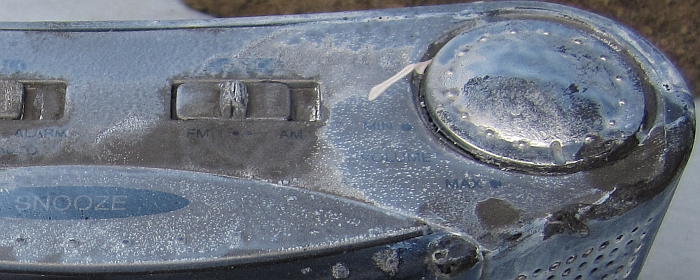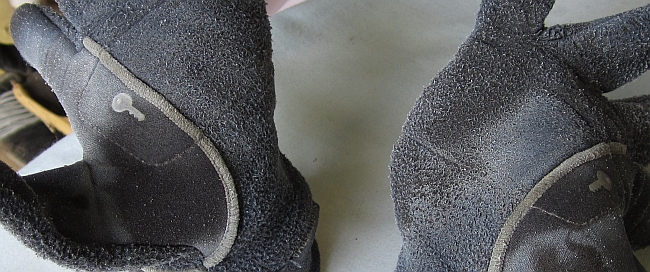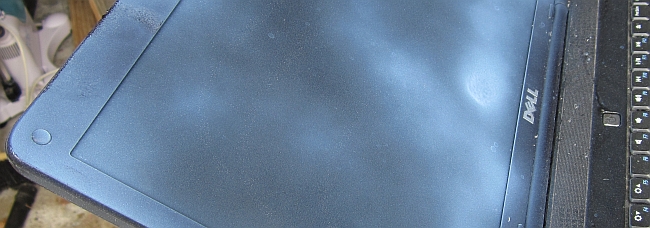NeverWet: Superhydrophobic or Snake Oil?
“This is cool”, I thought, as I watched the video. Now close to 6 million views on YouTube, I probably wasn’t the only person who saw NeverWet and thought this product held great promise. NeverWet is a two-step spray-on coating that promises to make all sorts of surfaces superhydrophobic (extremely water repellent). The two steps include a “base” coating and a “top” coating, each coat taking about 30 minutes to dry. Once finished, the coating takes on a white hazed look. Today, I found NeverWet at a local Home Depot and decided to take the product for a spin and see if it protects as well as it says, how it looks and whether I might use it.
NeverWet is fascinating as a product, but probably more intriguing is the conflict between some marketing materials, video and the packaging itself. Looking at the included Frequently Asked Questions, it’s clearly stated that you are not to use the product on electronics.
While it makes sense, the demo video found on YouTube (you’ll find the below scene at 4:33) seems to directly contradict this, even going as far as showing an iPhone (apparently treated with NeverWet) submerged in water. If you look closely at the “coated” phone, it shows no signs of being covered by NeverWet. In fact, the person in the video never actually sprays the phone.
So what gives? Did they over-promise, and under-deliver? Did the product change after the marketing process started? Did they just flat-out lie about the product’s capabilities? I decided to run my own entirely unscientific tests to see if this product was as good as they say, whether or not I’d use it on electronics and even if I could submerge an electronic device after treating it.
The first thing I can tell you after trying this is that it makes everything you spray look ugly. If the surface isn’t a very light colour or white, NeverWet is going to make it look like the object survived an explosion. In one case, on a clock radio I tried, NeverWet even caused the surface grey colour to bleed. Take a look at this:
You probably don’t want any of your stuff to look like that right? As the FAQ mentions, never use this stuff on electronics (but I did anyway). You’ll notice the surface colour and texture too; not pretty. A NeverWet treatment makes everything you spray look foggy, white, and feel like sandpaper. In fact, looking at a treated object from afar, you might think it was frozen. Generally, something like this probably works best on a concrete surface or maybe outside piping – even still, I felt challenged to find novel uses. I decided to do some wild tests on fabric and electronics to see what was possible. You should follow the instructions and not do this.
Of particular interest to me was the concept of “Abrasion”. How likely was it that a NeverWet treatment was going to come off after rubbing it on something or even being bombarded by water? The NeverWet FAQ explains it like this:
Glove Test
For this test, I grabbed my everyday motorcycle gloves. Mostly a fabric and porous, I expected these qualities to be a serious challenge for the spray product. And, I was right. Not only was spraying an extra-base coat on the gloves futile, NeverWet wasn’t very good at stopping water. It kept some water from getting into the glove, but not enough to keep my hands dry. After the spray had cured, I made a video of pouring water on the gloves. At the end of the video, my hand was wet.
Clock Radio Test
Next, I took an old, barely working clock radio and thought I’d spray it as a casual user might (I didn’t open the device up and spray the base electronics, just the surface). I imagined how a person might think this would protect a device from getting wet and the casual user might take them outside and let it get rained on. After spraying the radio with NeverWet, the colours began to bleed and the clock went from looking horrible to look worse. Ultimately, there was only one thing left to do – dunk it in water. Here’s a video of how that went. Needless to say, the outside stayed dry, but the inside was destroyed. I also notice NeverWet has sticky and tacky qualities, which made the volume controls and buttons on the device harder to move or unusable.
Laptop Test
My last, and perhaps most curious attempt was to treat a laptop screen with NeverWet’s protection. Clearly, this was breaking every rule possible. Given the laptop was dead, that’s ok. I still wanted to see what would happen. Firstly, this white milky covering guaranteed the screen would be unviewable. Not unexpected, but still ugly. Incredibly, NeverWet is a champ when it comes to smooth, flat surfaces. When I grabbed some water and poured it over the screen, the water beaded away and dropped. Take a look at this video to see it.
I was also interested in testing how easy the coating would come off. For this, I used a simple garden hose and sprayed the screen directly for about 20 seconds. When I was finished spraying, it was clear that a large amount of NeverWet came off and the screen was no longer being protected. I wondered if simple heavy rain or use of an object over time would cause the same wearing.
Now that I’ve seen the product on gloves, a radio and even a laptop screen, I can see the product does repel water, but it is probably not something you’d want to use on very many things. Given that NeverWet will make what you treat look ugly, will probably be easily worn down, and reverses any sort of transparency – you’ll have a difficult time trying to find a use for this product. Perhaps it could be for those bricks near your patio that no one walks on? Maybe it could be for the wood that sits outside (that no one sees)? NeverWet works as a water repellent, but for $25.97, that’s a lot of cheese for something that seems cool but in practice has few uses. Would I put this on an iPhone? never ever.
What might you use this product?
NeverWet is a spray-on coating under the Rust-Oleulm brand. The package includes a base and top coat and sells online at Amazon US or in Canada on Home Depot and other stores.









